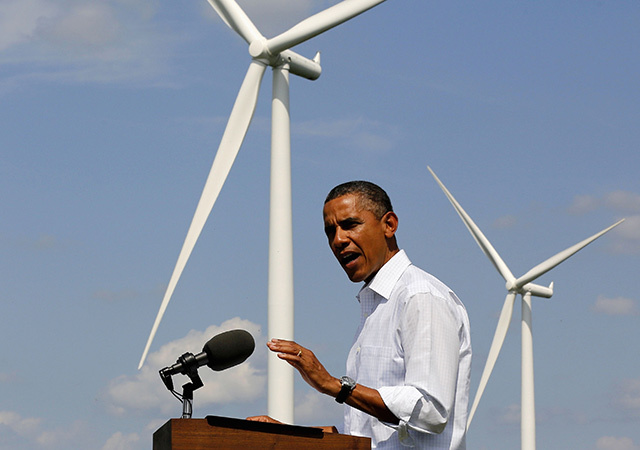
Actress Daryl Hannah hasn’t chained herself to the White House fence in support of tougher power plant emissions.
Maybe she should.
Limits on smokestack emissions that the Obama administration will propose in three days could have 10 times the impact on carbon emissions as the issue Hannah and other celebrities have protested: the proposed Canada-to-U.S. Keystone XL oil pipeline.
“Keystone doesn’t really matter in terms of lowering emissions,” said Amy Myers Jaffe, executive director of energy and sustainability at the University of California-Davis. “It shows an over-emphasis on strategy versus content.”
The U.S. Environmental Protection Agency estimates Keystone could add 18.7 million metric tons annually of heat-trapping carbon dioxide to the atmosphere. The power-plant rules President Barack Obama will announce June 2 could slash emissions by 169 million metric tons a year, according to a forecast by Kevin Book, managing director at ClearView Energy Partners LLC, a financial research group in Washington.
Nevertheless, celebrity activists have come out against Keystone, a proposed pipeline to carry Canadian oil sands to U.S. refineries. Actors Mark Ruffalo, Robert Redford, Kyra Sedgwick, Jared Leto and Julia Louis-Dreyfus have protested against Keystone. “Splash” star Hannah has been arrested at least three times at Keystone protests — once after chaining herself to the White House fence.
The State Department is preparing a recommendation on TransCanada Corp.’s application to build the $5.4 billion, 1,661-mile (2,673-kilometer) pipeline from Hardisty, Alberta, to refineries along the Gulf Coast. The deliberations are currently on hold, awaiting the resolution of a legal dispute over how the route through Nebraska was approved.
While concerns over water have energized opponents in Nebraska, it’s greenhouse-gas emissions that have triggered protests at the gates of the White House. The fact that Keystone has a smaller carbon footprint than power plants doesn’t undermine the effort, said Anthony Swift, an international attorney at the Natural Resources Defense Council.
“It really represents not just what energy choices we’re making today but what energy choices we want to lock ourselves into through 2065 and beyond,” Swift said in an interview. “So this idea that there’s a tension between them and you can’t both clean up our power sector while preventing increasingly carbon- intensive fuels is a false choice.”
Plants Closing
The EPA’s rules curbing pollutants are leading utilities to shut coal-fired power plants. In 2011 and 2012, coal units capable of generating 14 gigawatts of electricity were shuttered. Another 63 gigawatts — more than a fifth of the coal fleet — may disappear by 2017, according to projections by Bloomberg New Energy Finance.
Still, coal remains the No. 1 source of fuel for power plants in the U.S., though its share of power generation fell to 38 percent last year from almost half in 2007.
Whatever its environmental impact, Keystone’s political implications loom large. Republicans and Democratic candidates for U.S. Senate who are running in key energy states such as Alaska and Louisiana, are pressuring Obama to approve the project, first proposed in 2008. Delays while the State Department evaluates the project’s environmental impacts have frustrated Canadian Prime Minister Stephen Harper.
A State Department environmental review concluded that Keystone will have little impact on climate change because most of the oil it would carry will get to market by trains or other pipelines.
Still, Canadian crude, which is bound up in sand and dirt, requires more energy to extract and emits about 17 percent more greenhouse gases than other heavy oil used in the U.S., according to the State Department. It must be diluted with bitumen, a semi-solid form of petroleum, to be transported by pipeline.
And while it’s unclear how big an impact the EPA power plant rules will have until they are released, greenhouse-gas emissions cut under the rules are sure to overwhelm the pollution from Keystone, Book said.
For some activists Keystone “is a single piece of infrastructure that could pave the way to the production of resources throughout the entire Western Canada Sedimentary Basin,” Book said. “A victory against a pipeline, from that perspective, could be a symbol of a victory against an entire class of hydrocarbon production.”
Even if Obama approves Keystone, there will be a silver lining for environmental groups, according to Tyson Slocum, energy-program director at Public Citizen, a nonprofit consumer watchdog group in Washington.
“A real legitimate grassroots army was created through the Keystone movement that can be very easily adapted and translated to other climate fights,” Slocum said in an interview.
Recommended for you
